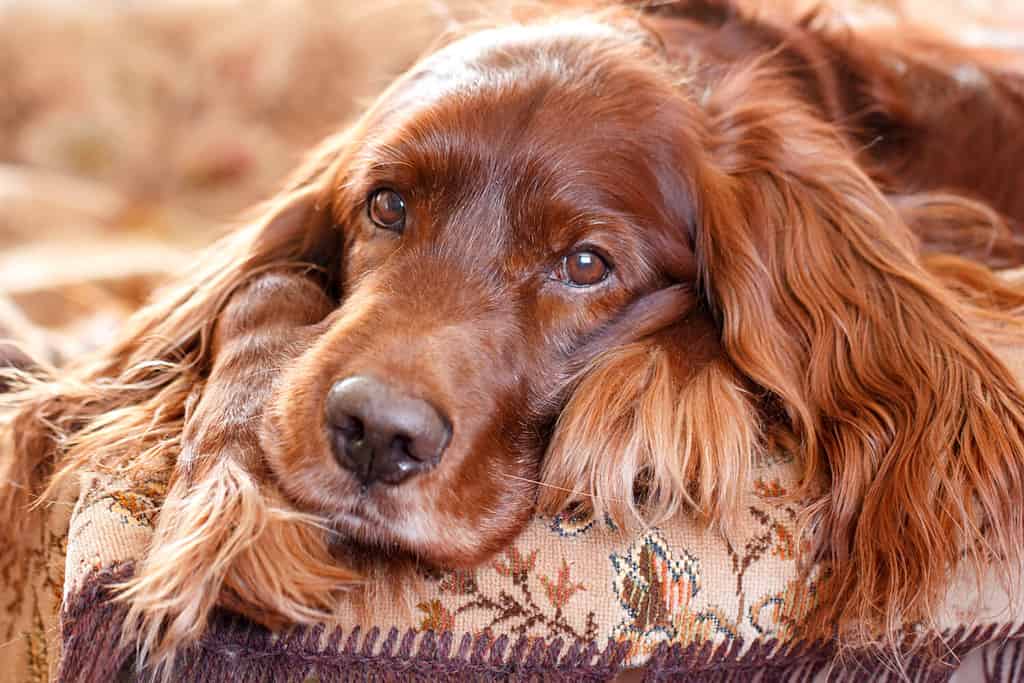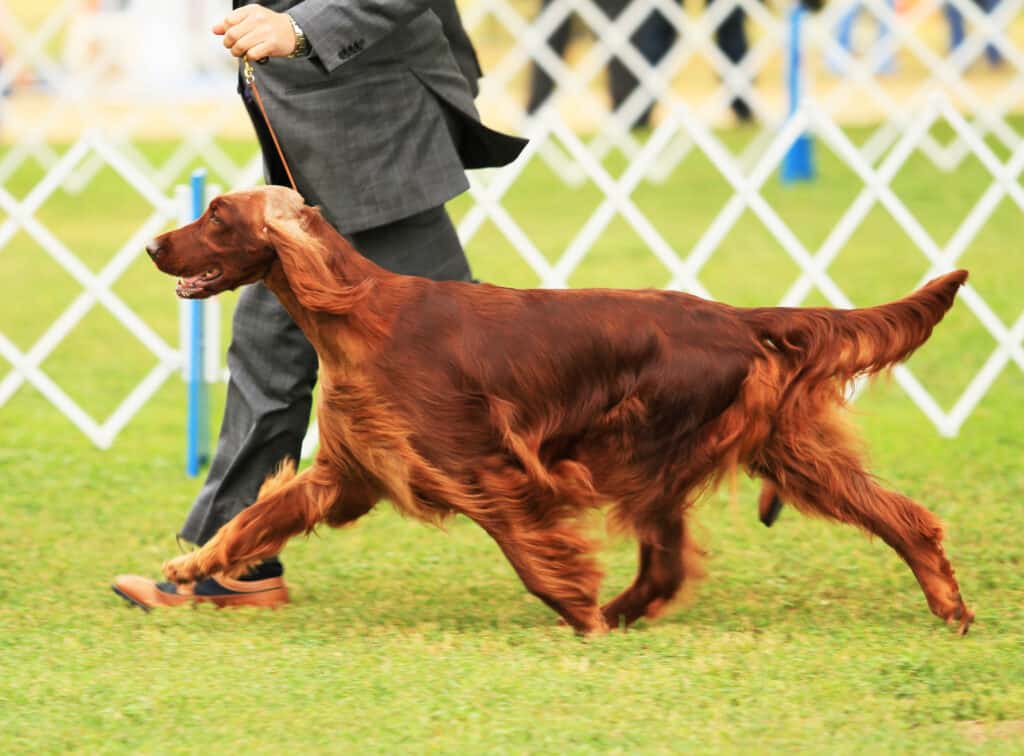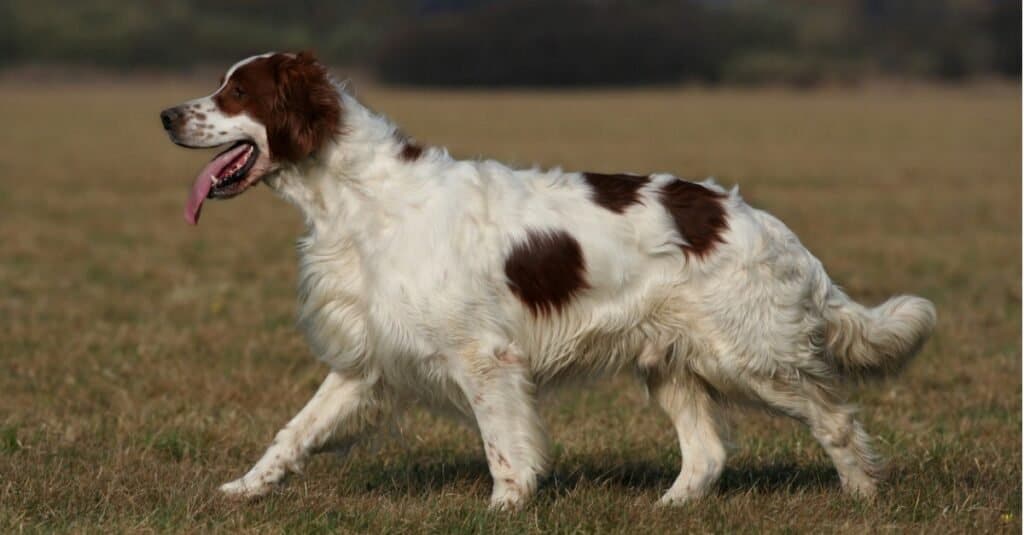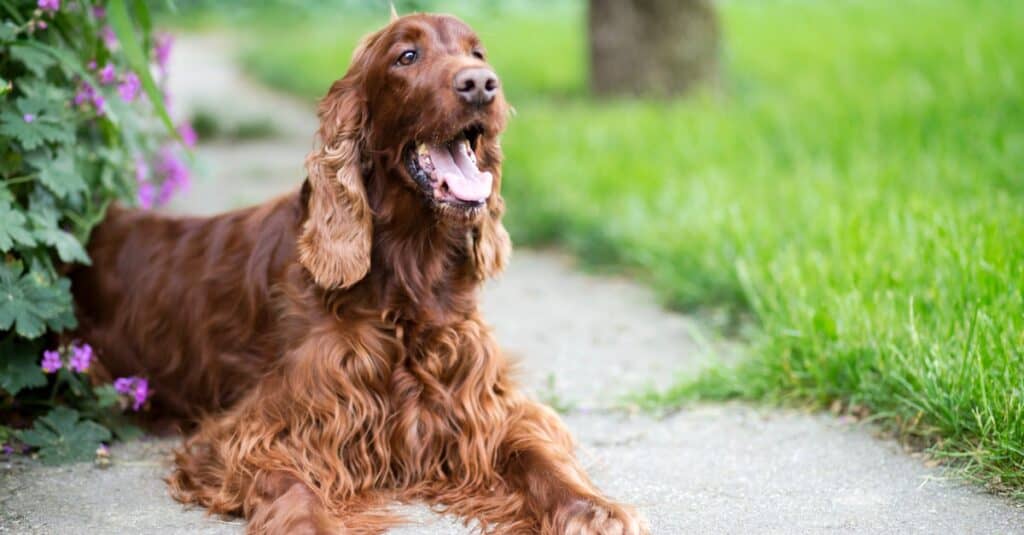Irish setters make wonderful companion dogs. As a member of the sporting group, these good-natured dogs are active and outgoing — the perfect combination for an adventure buddy, farm hand, or playful best friend.
When adopting an Irish setter, there are a few different colors in which Irish setter coats will come. According to the official breed standard from the American Kennel Club, the standard coat color should be either a “mahogany or rich chestnut red with no black,” and small white markings on the chest, toes, throat, and skull are acceptable as well.
Thinking about adopting an Irish setter and want to know what colors they come in? Discover the most common Irish setter colors and markings below.
Chestnut

Chestnut Irish setters have the lightest color coat.
©Kseniia Kolesnikova/Shutterstock.com
As a purebred dog breed, the Irish setter has been selectively bred over hundreds of generations to achieve the three current coat colors. The signature chestnut coat color pairs well with the similar colors of mahogany and red and a litter of puppies may have one or many chestnut-coated pups depending on lineage.
Officially dubbed as “rich chestnut,” the chestnut-coated Irish setter has less red and orange pigments in its silky coat. Instead, yellow and brown shine through more. Chestnut Irish setters may have black or white markings, though black is very rare.
Mahogany

The mahogany Irish setter has a color between chestnut and red.
©DragoNika/Shutterstock.com
Mahogany-coated Irish setters have a deep orange-red-brown coat (with or without white markings). According to Purina, the Irish setter became a general gundog and pointer after repeated use in hunting proved fruitful. The mahogany-coated Irish setters became especially eye-catching and were introduced to showing as they gained notoriety in the canine world.
Red

Red Irish setters are iconic at competitions and shows.
©Canden Scales/Shutterstock.com
The most classic color for an Irish setter’s coat is a warm, luscious red coat. Hailing from the Emerald Isle, this red coat falls in with the local stereotypical (yet iconic) red hair — so much so that some animal behaviorists term Irish setters as “redheads with a heart of gold.”
The vibrant red coat of an Irish setter is less “red” and more of a deep burgundy-brown. In the light of the sun, more stunning shades of red will come through. The melanin pigment pheomelanin causes the “red hair” of an Irish setter.
White Markings

Irish red and white setters are known for their power and athleticism.
©iStock.com/Wavetop
Most Irish setters have little to no markings on them. If they do, however, it’s usually a bit of white markings somewhere on their bodies. For show-ready Irish setters, as mentioned above, a narrow sliver or sprinkling of white markings on the chest, toes, throat, and skull remain permissible under AKC standards for Irish setters.
For Irish setters not competing, the markings don’t matter! Some Irish setters appear white and red — their markings tend to look red on a coat of white. Owners who have Irish setters with a patchwork-esque coat of red and white may choose to cut the hair down a bit shorter than the flowing manes of standard chestnuts, mahoganies, and reds.
While rare, some Irish setters may be born with chests of white — from their neck to their abdomen, the bottom of their body is a stark white against either chestnut, red, or mahogany colors.
Grooming Your Irish Setter

The Irish Setter is a graceful hunting dog.
©iStock.com/Wavetop
Whether your Irish setter has a red, mahogany, or chestnut coat — with or without markings — its feathery hair demands weekly care to maintain its sheen.
Expect to groom your Irish setter at least twice a week, but daily is ideal. Perform this daily brushing with either a pin brush or a soft bristle brush to untangle small knots and run the full length of the long hair. If your setter’s coat begins to form larger knots or mats, opt for a long-toothed metal comb to work them out.
When it comes to shampoo for your Irish setter, choose a reliable brand that has gentle cleaning properties and benefits for the skin. Some highly recommended shampoo brands for Irish setters include:
- Healthy Breeds Irish Setter Deodorizing Shampoo
- TropiClean 2-in-1 Papaya and Coconut Shampoo
- WAHL Oatmeal Formula with Coconut Lime Verbena Shampoo
According to X, setters won’t need to be bathed all too often. Occasional baths with daily brushing and monthly nail clippings will keep your Irish setter’s coat shiny, skin healthy, and paws happy.
Silky, Stunning Setter Coats
Irish setters have rich coats in chestnut, mahogany, and red colors with or without white markings. To take care of your Irish setter’s coat, ensure you have a pin brush or a soft bristle brush for daily or weekly brushing sessions.
The photo featured at the top of this post is © Wirestock/iStock via Getty Images
Ready to discover the top 10 cutest dog breeds in the entire world?
How about the fastest dogs, the largest dogs and those that are -- quite frankly -- just the kindest dogs on the planet? Each day, AZ Animals sends out lists just like this to our thousands of email subscribers. And the best part? It's FREE. Join today by entering your email below.
Thank you for reading! Have some feedback for us? Contact the AZ Animals editorial team.






